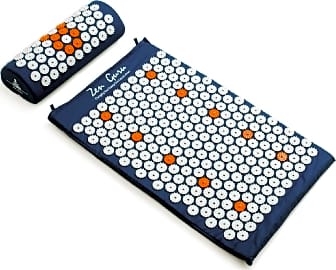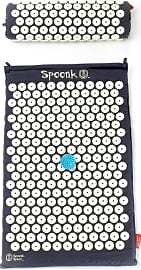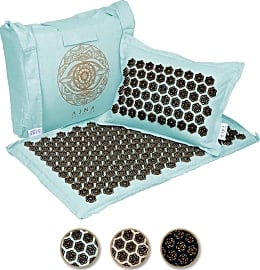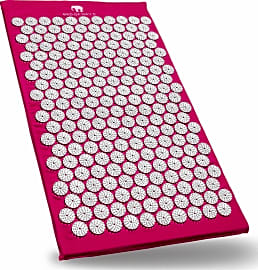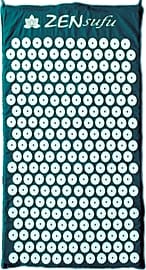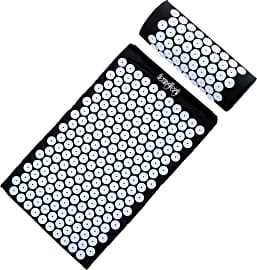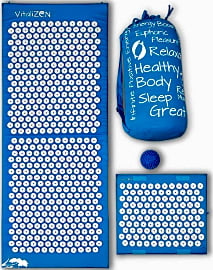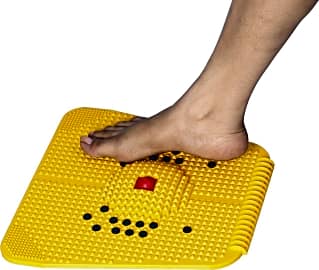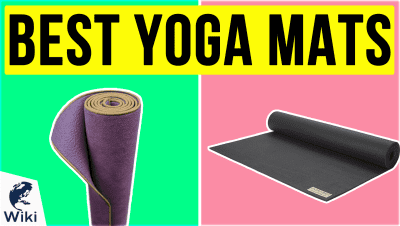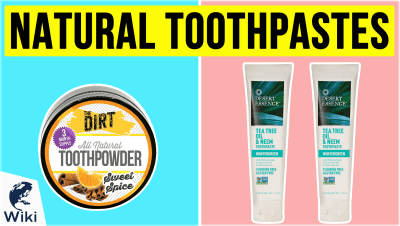The 10 Best Acupressure Mats

This wiki has been updated 38 times since it was first published in April of 2015. Claiming to relieve nausea and vomiting, lower back pain, tension headaches, stomachaches, and a host of other ailments, these acupressure mats may just help you get rid of that nagging problem you've been dealing with. They're offered in a range of sizes and shapes, so you can target various body parts, and include handy extras, from carrying bags to spiky massage balls. When users buy our independently chosen editorial picks, we may earn commissions to help fund the Wiki.
Editor's Notes
February 21, 2020:
An acupressure mat isn't a guaranteed solution to chronic pain or muscle tension, but many users find a measure of relief — once they grow used to the interesting sharp sensation. That said, if you have a chronic illness or medical condition, you may want to check with your doctor before using one.
At this time, the ProSource Set and Spoonk Three-Piece remain tough to top; they're sharp enough without being unnecessarily painful. The former arrives with a cushion for your head, while the latter has a travel-size mat that can be rolled into one. Plus, the ProSource model is offered in a wide range of colors, from pink to black, so there's an option for all tastes. We have removed the Kendal B-Mattress at this time, however, as the projections are just too dull. We also opted to remove the Rosenice Walk Stone over concerns about its overall durability. If it is relief for your feet you're looking for, consider the Super India Store Total Health or the Byriver Jade Spring Slippers, instead. The latter give you some mobility, unlike a traditional mat, but don't expect to be able to wear them all day long. Finally, we have selected the popular Ajna Eco Luxe. True to its name, it boasts environmentally friendly materials and construction, and it comes in several soft and natural colors that will complement your home décor or yoga mat. The included mat is just a touch shorter than some, however.
Special Honors
Dosha Mat Even though the Dosha Mat is lightweight at 2.5 pounds and easy to stash away in a closet, its attractive styling might just entice you to leave it out where all can see. Crafted from natural linen, they feature either lavender or turquoise lotus flowers, and thanks to the removable cushion, they're also quite comfortable. doshamat.com
What Is Acupressure?
Any effects caused by these practices were written off as random chance or the placebo effect.
Acupressure is perhaps one of the oldest known healing modalities. It is the seemingly simple act of stimulating key healing points along the energetic meridian lines of the body. This stimulation is said to activate the body's ability to cure itself. Acupressure has gained popularity in the Western populace largely due to the introduction of various easy to use acupressure pads. The practice has only recently gained clout in Western science, though acupressure in Asian countries is thousands of years old.
Practitioners stimulate acupoints using the fingers, knees, elbows, and various soft stone, wood, or plastic tools. This stimulation releases blocked energy, or chi. This release restores balance to the body systems or organs that the acupoints are attached to. Chronic ailments can be relieved through regular application of pressure to these specific acupoints.
Physically, these acupoints are bunches of nerve endings in various areas of the body. Energetically, these would be called the body's meridians. In the 21st century, science caught up with the knowledge of these millennia-old systems of healing. What has always been called meridian lines in traditional Chinese medicine is now known as the primo vascular system in Western medicine.
While Eastern medicine has always enjoyed a legacy of success in treating many acute and chronic disorders, scientists refused to accept methodologies such as acupressure due to the lack of a physical anatomical system which they affect. Any effects caused by these practices were written off as random chance or the placebo effect.
Due to the sheer number of success cases and scientific papers reporting the physiological evidence of these practices, the existence and implications of the primo vascular system came to light. This provides not only an energetic basis for the healing provided by acupressure, but also a measurable physical basis as well.
Acupressure Versus Acupuncture
The physical measurement of meridian lines is important to both acupressure and acupuncture. Both practices focus on a holistic approach to healing, and see injuries as the effects of chi blockages in the body. In addition to physical practice, lifestyle recommendations will be made by practitioners of either modality. Both practices involve focusing on healing these meridian lines rather than the physical manifestations of their blockages experienced as pain.
Acupressure and acupressure pads use gentle to firm pressure, where acupuncture uses needles to gently penetrate the skin.
The difference between acupressure and acupuncture is in the application of the treatment. Acupressure and acupressure pads use gentle to firm pressure, where acupuncture uses needles to gently penetrate the skin. When these centers are stimulated, they can release muscular tension and toxins, help circulate the blood, and enhance the body's inherent ability to heal itself.
Acupressure has received acclaim for its ability to reduce pain, and it is this effect that has caused acupressure techniques to be included in nearly every physical healing modality on the planet. All forms of massage involve acupressure, as does chiropractic care and physical therapy. Even transcutaneous electrical nerve stimulation is based on the ancient principles of acupressure.
Acupuncture uses these same tenements, but stimulates them through inserting very thin needles into the skin. The idea is unsettling to many people, though those that experience it have positive results. The meridian flow in acupuncture has been measured well, but until recently was poorly understood. Thanks to the discovery of the primo vascular system, both of these modalities may now be known around the world for the healing capabilities they possess.
The Benefits Of Using Acupressure Mats
Acupressure mats provide users with the benefits of acupressure without the need for an office visit. Mats provide hundreds, if not thousands of pressure points, and can stimulate the chi quickly and easily with any amount of pressure desired. Because of the nature of acupressure, an acupressure mat will quickly relieve muscular tension. This is perfect if certain muscles of the body have been overworked or over stressed. Many users with lower back pain find relief by laying on an acupressure mat for twenty minutes each day.
This can effect the physical body as well, reducing metabolism, lowering the immune system, and causing a sense of feeling stuck.
Using an acupressure mat may also help induce sleep in restless patients. At least one study has confirmed that acupressure can be used as a non-pharmacological therapy for insomnia and restlessness. This particular study investigated the claim of traditional Chinese medicine that acupressure induces sedation. The results suggested that acupressure not only helped patients feel tired and fall asleep easier, they also stayed asleep throughout the night more frequently than control groups.
Acupressure has even been studied for its ability to eliminate chemotherapy induced vomiting. After many pharmacological methods to reduce vomiting failed, researchers considered patients for a natural treatment option using acupressure. The results strongly indicated the use of acupressure for relieving vomiting.
Healing emotional pain is also a possibility with acupressure. Significant emotional stress causes the body to slow down. This can effect the physical body as well, reducing metabolism, lowering the immune system, and causing a sense of feeling stuck. These combined maladies can lead to depression if left unchecked. A twenty minute session with an acupressure pad can stimulate the flow of energy throughout the body, helping the user feel less stuck while simultaneously rekindling the flow of stagnant energy in the body.


